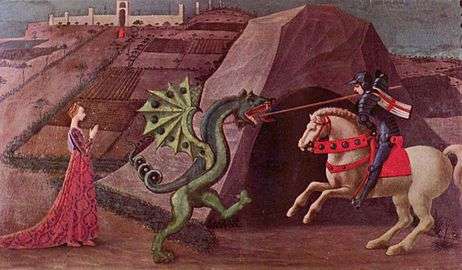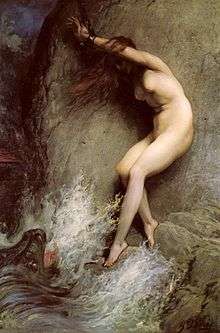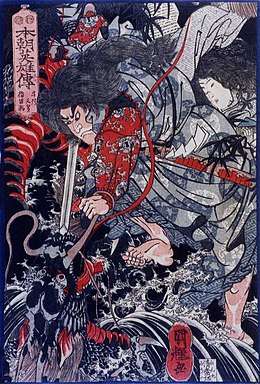Dragonslayer
A dragonslayer is a person or being that slays dragons. Dragonslayers and the creatures they hunt have been popular in traditional stories from around the world: they are a type of story classified as type 300 in the Aarne–Thompson classification system.[1] They continue to be popular in modern books, films, video-games and other entertainments. Dragonslayer-themed stories are also sometimes seen as having a chaoskampf theme - in which a heroic figure struggles against a monster that epitomises chaos.

Description

A dragonslayer is often the hero in a "Princess and dragon" tale. In this type of story, the dragonslayer kills the dragon in order to rescue a high-class female character, often a princess, from being devoured by it. This female character often then becomes the love interest of the account. One notable example of this kind of legend is the story of Ragnar Loðbrók, who slays a giant serpent, thereby rescuing the maiden, Þóra borgarhjörtr, whom he later marries.
There are, however, several notable exceptions to this common motif. In the legend of Saint George and the Dragon, for example, Saint George overcomes the dragon as part of a plot which ends with the conversion of the dragon's grateful victims to Christianity, rather than Saint George being married to the rescued princess character.
In a Norse legend from the Völsunga saga, the dragonslayer, Sigurd, kills Fafnir - a dwarf who has been turned into a dragon as a result of guarding the cursed ring that had once belonged to the dwarf, Andvari. After slaying the dragon, Sigurd drinks some of the dragon's blood and thereby gains the ability to understand the speech of birds. He also bathes in the dragon's blood, causing his skin to become invulnerable. Sigurd overhears two nearby birds discussing the heinous treachery being planned by his companion, Regin. In response to the plot, Sigurd kills Regin, thereby averting the treachery. [2]
Mythologists such as Joseph Campbell have argued that dragonslayer myths can be seen as a psychological metaphor:[3]
"But as Siegfried [Sigurd] learned, he must then taste the dragon blood, in order to take to himself something of that dragon power. When Siegfried has killed the dragon and tasted the blood, he hears the song of nature. he has transcended his humanity and re-associated himself with the powers of nature, which are powers of our life, and from which our minds remove us.
...Psychologically, the dragon is one's own binding of oneself to one's own ego." [4]
Dragonslayer characters

- Antiquity
- Enki
- Ninurta
- Inanna
- Marduk
- Ra
- Teshub
- Indra
- Baal
- El (deity)
- Yahweh
- Archangel Michael
- Apollo
- Zeus
- Jupiter
- Perseus
- Heracles
- Saint George
- Vahagn
- Tarḫunz
- Cadmus
- Rostam
- Fereydun
- Garshasp
- Yu the Great
- Erlang Shen
- Eurybarus
- Mwindo
- Medieval and early Modern legend
- Guy of Warwick
- Baldr
- Beowulf
- Sigurd or Siegfried
- Tristan
- Margaret the Virgin
- Heinrich von Winkelried
- Gawain
- Dobrynya Nikitich
- Skuba Dratewka/Krakus
- Drangue
- Susanoo
- Nezha
- Lancelot
- Făt-Frumos
- Fráech
- Bayajidda
- Bahrām Gūr
- Iovan Iorgovan
- Haymon
- Tokoyo
- Wada Heita Tanenaga
- John Lambton
- Mamadi Sefe Dekote (Africa)
- Benzaiten aka Saraswati
- Teodosio de Goñi
- Tolkien's legendarium
- Túrin Turambar
- Eärendil
- Fram
- Bard the Bowman
References
- Thompson, Stith. The Folktale. University of California Press. 1977. p. 27. ISBN 0-520-03537-2
- Byock, Jesse L. (1990). Saga of the Volsungs: The Norse Epic of Sigurd the Dragon Slayer. Berkeley, Los Angeles, London: University of California Press. ISBN 0-520-23285-2.
- The Power of Myth, Joseph Campbell with Bill Moyes, Anchor Books 1988 ISBN 978-0-307-79472-7
- The Power of Myth, Joseph Campbell with Bill Moyes, Anchor Books 1988 ISBN 978-0-307-79472-7
Further reading
- Davis, S. "Argeiphontes in Homer--The Dragon-Slayer." Greece & Rome 22, no. 64 (1953): 33-38. www.jstor.org/stable/640827.
- d'Huy, Julien. (2013). Le motif du dragon serait paléolithique : mythologie et archéologie. Préhistoire du Sud-Ouest. 21. pp. 195-215.
- d'Huy, Julien. (2014). Mythologie et statistique. Reconstructions, évolution et origines paléolithiques du combat contre le dragon.. In: Mythologie française. pp. 17-23.
- Hart, Donn V., and Harriett C. Hart. "A Philippine Version of "The Two Brothers and the Dragon Slayer" Tale." Western Folklore 19, no. 4 (1960): 263-75. doi:10.2307/1497353.
- Järv, Risto. "“The Three Suitors of the King's Daughter": character roles in the Estonian versions of the Dragon Slayer (AT 300)". In: Folklore 22 (2002). pp. 33-48. https://www.folklore.ee/folklore/vol22/dragons.pdf
- Márkus-Takeshita, Kinga Ilona. "From Iranian Myth to Folk Narrative: The Legend of the Dragon-Slayer and the Spinning Maiden in the Persian Book of the Kings." Asian Folklore Studies 60, no. 2 (2001): 203-14. doi:10.2307/1179054.
- Ramsey, Jarold. "Ti-Jean and the Seven-headed Dragon: Instances of Native American Assimilation of European Folklore." In Reading the Fire: The Traditional Indian Literatures of America, 222-36. Seattle; London: University of Washington Press, 1999. www.jstor.org/stable/j.ctvcwn26j.18.
- Róheim, Géza. "THE DRAGON AND THE HERO." American Imago 1, no. 2 (1940): 40-69. www.jstor.org/stable/26300857.
- Róheim, Géza. "THE DRAGON AND THE HERO (Part Two)." American Imago 1, no. 3 (1940): 61-94. www.jstor.org/stable/26300866.
- Simpson, Jacqueline. "Fifty British Dragon Tales: An Analysis." In: Folklore 89, no. 1 (1978): 79-93. www.jstor.org/stable/1260098.
- SMITH, KAREN P. "SERPENT-DAMSELS AND DRAGON-SLAYERS: OVERLAPPING DIVINITIES IN A MEDIEVAL TRADITION." In Christian Demonology and Popular, edited by Klaniczay Gábor and Pócs Éva, by Csonka-Takács Eszter, 121-38. Central European University Press, 2006. www.jstor.org/stable/10.7829/j.ctt2jbmrh.10.
- VAN DER SCHAAF, BAUKJE FINET, Ruth Ditzel, and Erik Kooper. "The "Lai De Tyolet" and "Lancelot and the Whitefooted Stag": Two Romances Based on a Folktale Motif." Arthuriana 4, no. 3 (1994): 233-49. Accessed June 16, 2020. www.jstor.org/stable/27869068.
- Vaz Da Silva, Francisco. "Iberian Seventh-Born Children, Werewolves, and the Dragon Slayer: A Case Study in the Comparative Interpretation of Symbolic Praxis and Fairytales." Folklore 114, no. 3 (2003): 335-53. www.jstor.org/stable/30035123.
- Witzel, Michael. (2008). Slaying the Dragon across Eurasia. In: In Hot Pursuit of Language in Prehistory. pp. 263-286. 10.1075/z.145.21wit.
External links
